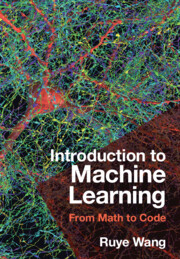Refine search
Actions for selected content:
491 results

Introduction to Machine Learning
- From Math to Code
- Coming soon
-
- Expected online publication date:
- January 2026
- Print publication:
- 18 December 2025
-
- Textbook
- Export citation
Parties’ Ideological Cores and Peripheries: Examining How Parties Balance Adaptation and Continuity in Their Manifestos
-
- Journal:
- British Journal of Political Science / Volume 55 / 2025
- Published online by Cambridge University Press:
- 15 December 2025, e174
-
- Article
-
- You have access
- Open access
- HTML
- Export citation
Diverging views between clinicians, service users, family caregivers and researchers on the classification of restrictive practices in mental health services
-
- Journal:
- Epidemiology and Psychiatric Sciences / Volume 34 / 2025
- Published online by Cambridge University Press:
- 12 December 2025, e59
-
- Article
-
- You have access
- Open access
- HTML
- Export citation
Chapter 7 - Magnetic Resonance Imaging in Dementia
- from Section 1 - Introductory Chapters on Dementia
-
-
- Book:
- The Behavioral Neurology of Dementia
- Published online:
- 17 November 2025
- Print publication:
- 11 December 2025, pp 105-123
-
- Chapter
- Export citation
Beyond human gold standards: A multimodel framework for automated abstract classification and information extraction
-
- Journal:
- Research Synthesis Methods ,
- Published online by Cambridge University Press:
- 17 November 2025, pp. 1-13
-
- Article
-
- You have access
- Open access
- HTML
- Export citation
The broad structure of psychopathology in the All of Us Research Program
-
- Journal:
- Psychological Medicine / Volume 55 / 2025
- Published online by Cambridge University Press:
- 14 November 2025, e344
-
- Article
-
- You have access
- Open access
- HTML
- Export citation
Chapter 5 - Classification and Epidemiology
-
-
- Book:
- Seminars in Child and Adolescent Psychiatry
- Published online:
- 10 October 2025
- Print publication:
- 30 October 2025, pp 67-80
-
- Chapter
- Export citation
Generic unfolding of an antiholomorphic parabolic point of codimension k
- Part of
-
- Journal:
- Ergodic Theory and Dynamical Systems , First View
- Published online by Cambridge University Press:
- 23 October 2025, pp. 1-31
-
- Article
-
- You have access
- Open access
- HTML
- Export citation
6 - Statistical Learning
- from Part III - Advanced Concepts
-
- Book:
- Statistics for Chemical Engineers
- Published online:
- 12 December 2025
- Print publication:
- 25 September 2025, pp 289-384
-
- Chapter
- Export citation
META BI: A tool for describing behavioural interventions
-
- Journal:
- Behavioural Public Policy , First View
- Published online by Cambridge University Press:
- 17 September 2025, pp. 1-28
-
- Article
-
- You have access
- Open access
- HTML
- Export citation
Knowledge, practice of medical waste classifications and related factors of health staff at Ho Chi Minh City District 4 Hospital
- Part of
-
- Journal:
- Antimicrobial Stewardship & Healthcare Epidemiology / Volume 5 / Issue S1 / May 2025
- Published online by Cambridge University Press:
- 03 September 2025, pp. s23-s24
-
- Article
-
- You have access
- Open access
- Export citation
The Rumpelstiltskin effect: therapeutic repercussions of clinical diagnosis
-
- Journal:
- BJPsych Bulletin , FirstView
- Published online by Cambridge University Press:
- 22 August 2025, pp. 1-5
-
- Article
-
- You have access
- Open access
- HTML
- Export citation
Integrated geochemical and thermobarometric approach to ascertain provenance and pressure–temperature conditions from detrital Himalayan garnets (Siwalik Group, Surai Khola, Nepal)
-
- Journal:
- Geological Magazine / Volume 162 / 2025
- Published online by Cambridge University Press:
- 18 August 2025, e24
-
- Article
-
- You have access
- Open access
- HTML
- Export citation
2 - Sources and Basic Principles of Property Law
-
- Book:
- Property Law in China
- Published online:
- 09 July 2025
- Print publication:
- 24 July 2025, pp 26-54
-
- Chapter
- Export citation
Chapter 3.8 - Electricity
- from Sec 3 - Physics
-
- Book:
- Dr Podcast Scripts for the Primary FRCA
- Published online:
- 19 June 2025
- Print publication:
- 03 July 2025, pp 406-416
-
- Chapter
- Export citation
Bulimia nervosa severity levels based on shape/weight overvaluation explain more variance in clinical characteristics than DSM-5 severity levels
-
- Journal:
- Psychological Medicine / Volume 55 / 2025
- Published online by Cambridge University Press:
- 30 June 2025, e181
-
- Article
-
- You have access
- Open access
- HTML
- Export citation
Chapter 43 - Chronic Pain
- from Section 4 - Walking the Walk (and Talking the Talk)
-
- Book:
- Robinson and Hall's How to Survive in Anaesthesia
- Published online:
- 09 June 2025
- Print publication:
- 26 June 2025, pp 237-241
-
- Chapter
- Export citation
Mixture credibility formulas
-
- Journal:
- Annals of Actuarial Science , First View
- Published online by Cambridge University Press:
- 19 June 2025, pp. 1-15
-
- Article
-
- You have access
- Open access
- HTML
- Export citation
1 - Introduction
-
- Book:
- Machine Learning in Quantum Sciences
- Published online:
- 13 June 2025
- Print publication:
- 12 June 2025, pp 1-13
-
- Chapter
- Export citation
3 - Phase classification
-
- Book:
- Machine Learning in Quantum Sciences
- Published online:
- 13 June 2025
- Print publication:
- 12 June 2025, pp 47-75
-
- Chapter
- Export citation

